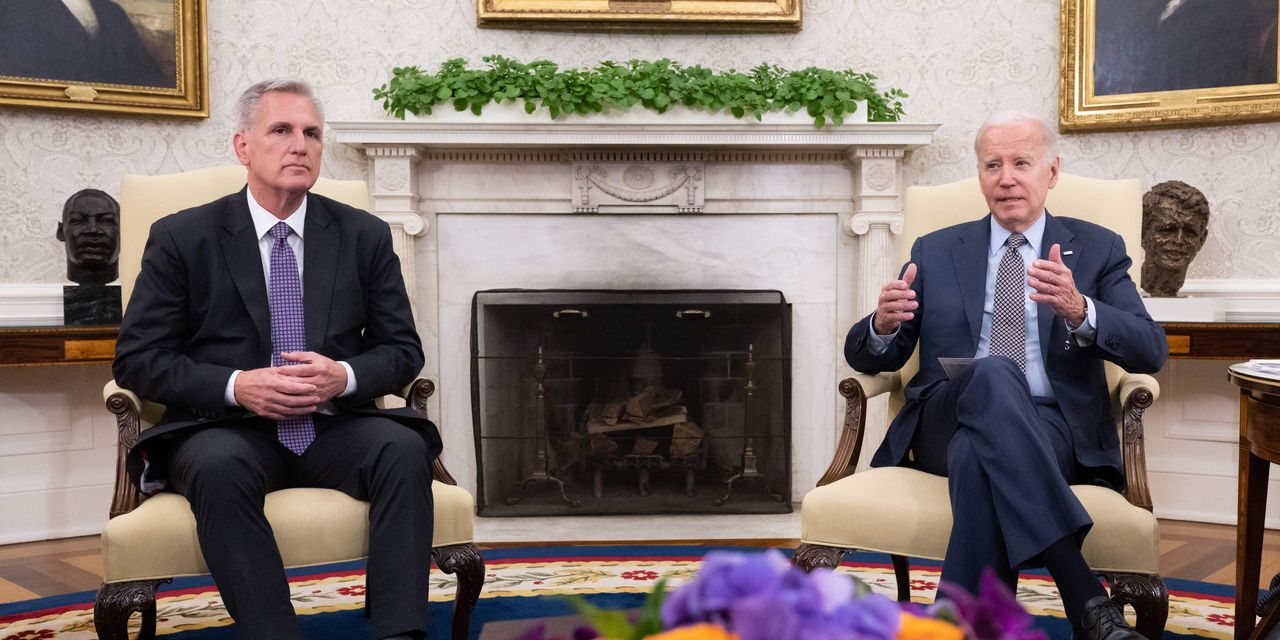The agreement that President Joe Biden and House Speaker Kevin McCarthy reached recently to suspend the U.S. debt ceiling until 2025 avoided immediate turmoil in financial markets but does little to avert the crisis that may be brewing due to huge federal deficits.
The deal cuts the 2024 deficit by $64.5 billion and offers plans to save $1.5 trillion over 10 years, but much could change depending on which political party controls Congress and the White House in 2025.
The plan leaves defense spending intact for the balance of 2024 and raises it 3% in 2025. It freezes non-defense spending for 2024 and permits a 1% increase in 2025. Work requirements for SNAP recipients have enough holes to make their consequences for the deficit quite small.
The Congressional Budget Office estimates the deficit would remain well above 5% of GDP. Publicly held debt will exceed GDP in 2024 and reach 115% by 2033. And these estimates are based on optimistic assumptions.
Not included is additional support for defending and rebuilding Ukraine, or that Congress may need to increase military spending to further support NATO and address tensions in the Middle East and the Pacific.
The analysis assumes nominal GDP will grow about 4% a year and the Federal Reserve will soon push inflation close to 2%. As this column has argued, the Fed will be challenged to keep inflation much below 4%.
Climate change and continuing hostilities in Ukraine are constraining global food supplies. Drought impedes ocean and river transportation systems. Derisking supply chains raises manufacturing costs and import prices too.
Mitigating climate change — replacing fossil fuels with solar and wind power, expanding electrical grids and deploying electric vehicles — requires massive investment and will higher prices for motor vehicles and other goods.
The CBO forecasts assume interest rates on Treasury securities average about 3%. To keep inflation in check, the Fed will likely have to maintain interest rates close to levels that prevailed before the 2008 Global Financial Crisis, rather than the extremely low rates just prior to the coronavirus pandemic.
The average maturity for Treasurys generally fluctuates between five and six years. During 2006 and until the Fed started cutting rates to cope with the financial crisis, the rates on Treasuries with those maturities was above 4%. Consequently, the CBO potentially underestimates federal interest payments after 2025 by about one-third.
“ Assuming no hiccups in growth makes little sense. ”
The CBO projects steady growth without another recession or similar disruption. Considering how the failure of the Silicon Valley Bank took Americans to the precipice of a financial crisis, assuming no hiccups in growth makes little sense.
Similarly, the chance of another of another pandemic in the next decade on the scale of COVID-19 is estimated to be 27.5%. Along with the challenges the Fed faces in accomplishing a soft landing, the likelihood that a financial crisis, pandemic, war or some other unforeseen event will disrupt growth for a year or two can safely be pegged at at least 50%.
Overall, the public’s share of U.S. debt should exceed 115% much sooner than 2033 and could reach 130% within the next 10 years. In this environment, the federal government will have to borrow each year enough to cover the difference between what it spends and receives in taxes, plus additional funds to pay for an increasing debt service.
The interest cost of servicing the national debt would increase faster than nominal GDP. Foreign central banks that keep Treasury securities as reserves, multinational businesses that use the U.S. dollar as their primary vehicle for cross-border transactions and private investors would all lose confidence in both the dollar and Treasury securities as a secure store of value.
These are the ingredients of a sovereign debt crisis. Like Greece, Spain and others in the wake of the Great Financial Crisis, the United States would have to implement draconian tax increases that would smoother growth, borrow at high interest rates or rely on the Fed to run the printing press, unleashing punishing rates of inflation that effectively devalue the currency and the debt.
“ It would be best to replace Biden in 2024. ”
The negotiations between Biden and McCarthy focused largely on non-defense discretionary spending. The antiquated state of IT systems at the Internal Revenue Service and the shut down of the nation’s air traffic control system last January bears witness that years of austerity to accommodate growing entitlements spending cannot continue without compromising basic governmental functions.
Read: How Joe Biden and Kevin McCarthy got to yes on their debt-ceiling compromise
Biden simply won’t seriously consider eligibility requirements and other cost-containment measures for Social Security, Medicare and Medicaid, food stamps, Section 8 housing assistance and other entitlements that comprise about two-thirds of federal spending.
The longer Americans wait, the harder it will be. It would be best to replace Biden in 2024, either with another Democrat or a Republican who is willing to rationalize the entitlements state.
Peter Morici is an economist and emeritus business professor at the University of Maryland, and a national columnist.
More: Biden is vulnerable in 2024, but Republicans offer too little in response
Also read: Biden’s trade protectionism is driving emerging countries into China’s hands
Read the full article here





